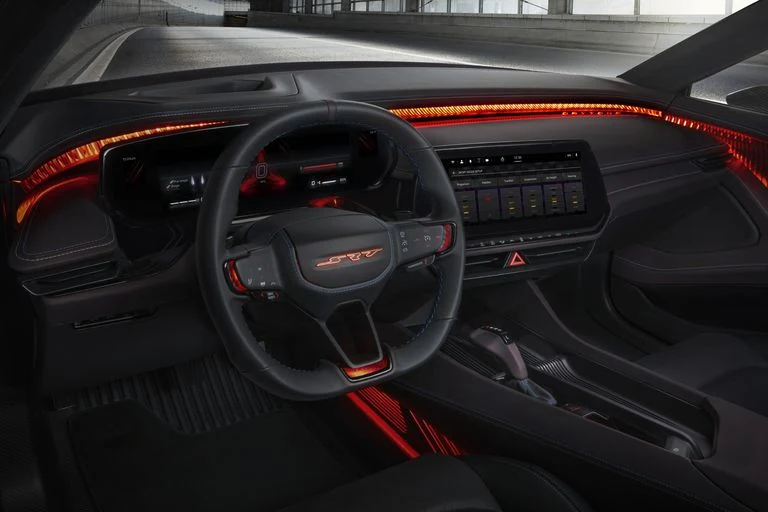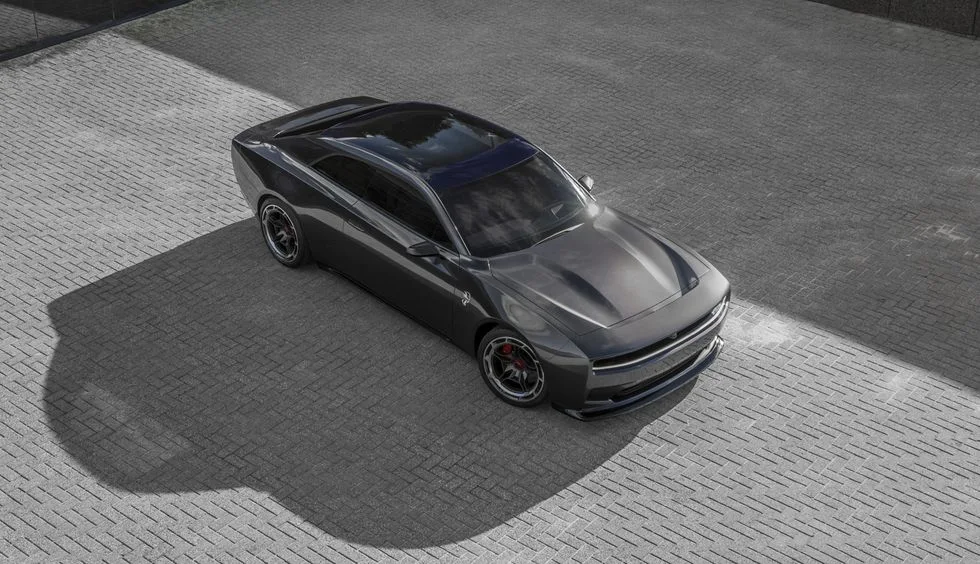Dodge's battery-electric muscle car is around the corner. But how many doors—and gears—will the production version have?
The EV space is filling up with high-performance cars from Porsche, Tesla, and others. It’s not uncommon for a car weighing nearly three tons to reach 60 mph quicker than a Ferrari F40. Though, that neck-snapping thrust comes without the drama associated with turning hydrocarbons into noise. Most electric vehicles are also chasing the most efficient ways to cheat the air. Dodge deviates from the norm with its Dodge Charger Daytona SRT battery-electric concept.
Dodge hasn’t revealed many details about the Daytona SRT's powertrain, such as battery size and number of motors. But Dodge has made it clear the production plan for its EV muscle car will include three different powertrains that are spread across three trim levels. Direct Connection will then offer two kits per trim level, depending on how fast you want to take your Dodge muscle machine. Considering Dodge is the company to shuffle an 840-hp Challenger to the showroom, we’re trusting the production version won’t disappoint.
The Charger Daytona SRT is intended to take Dodge into a battery-electric future. The brand plans to get there with a technology new for EVs: a multi-speed, electro-mechanical transmission. While it’s an automatic and its magic remains locked behind the Stellantis R&D walls, this system carries the eRupt name and promises to give a similar feel to a modern step-gear automatic.
Besides the multi-speed transmission, this Dodge EV concept has an exhaust system, sort of. Clearly, there's no combustion, so it’s not technically an exhaust pipe. Dubbed the Fratzonic Chambered Exhaust, this system replaces the traditional exhaust note with a facsimile. Without revealing details—again—Dodge says it’s not just a speaker churning out simulated combustion noise. It’s likely some sort of pump that pushes air through a device to generate sound. In a world of nearly silent EVs, Dodge promises this one will be loud: 126 dB—that’s the same peak noise rating as your current Charger SRT Hellcat.
Dodge also eschews the current design direction of high-performance electric cars. The nose of the Charger Daytona SRT looks more like a B-body Mopar than what we’re used to seeing from current EVs. The brand isn’t just using the Daytona name in vain but instead is applying some lessons the company learned with its big-winged race cars. Dodge calls its aerodynamic nose the R-Wing, likely in honor of the original Charger Daytona’s aerodynamic mastermind Gary Romberg.
 |
| Aerodynamic R-Wing leads the way for Dodge Charger Daytona SRT. |
This special wing helps move air where it's needed and allows for a more traditional front fascia. Still, Dodge says this concept is 25% smoother than the current Charger, which would give it a drag coefficient near 0.25. That would lag behind the current Tesla Model S Plaid, but still in the fight with other EVs.
The rest of the Charger Daytona SRT looks like a modern muscle car—with two doors, like the original Charger. Whether a production Charger EV has two doors or four remains to be seen, but this two-door concept rides on a set of center-lock wheels, which likely won’t make production, but the ultra-wide rubber isn’t out of the question. Dodge’s designers did follow one trend: lighting. The Charger Daytona SRT features extensive and expansive exterior lighting to help give the car more attitude.
The interior features a similarly aggressive lighting scheme, though it forgoes any nostalgia and the cabin is decidedly modern, in the same Cyber Punk aesthetic that is sweeping the industry. Looking more like a show car than something headed to production, the Charger Daytona SRT is equipped with four lightweight bucket seats.
Electric vehicles are fundamentally heavy because of their battery packs, though the folks at Dodge are trying to combat that heft by adding lots of lightweight carbon fiber. Carbon-fiber floors add rigidity, but those weight savings would likely be offset by the panoramic glass roof.
 |
| Dodge Charger Daytona SRT interior. |
If this Dodge Charger concept doesn't live up to the demands or expectations of Mopar devotees, it’s not for a lack of trying. Dodge doesn't want to deliver the best EV on the road, or a world-beating sports car. Instead, the company wants to give its fans what they want: a brutal muscle car with gobs of attitude. Let's hope the production version of Dodge’s electric car lives up to that ethos.
Do you think Dodge’s EV muscle car hits the mark? Or is the Charger Daytona SRT’s lack of internal combustion just too far? Please share your thoughts below.
(Article by Wesley Wren republished from autoweek.com)
